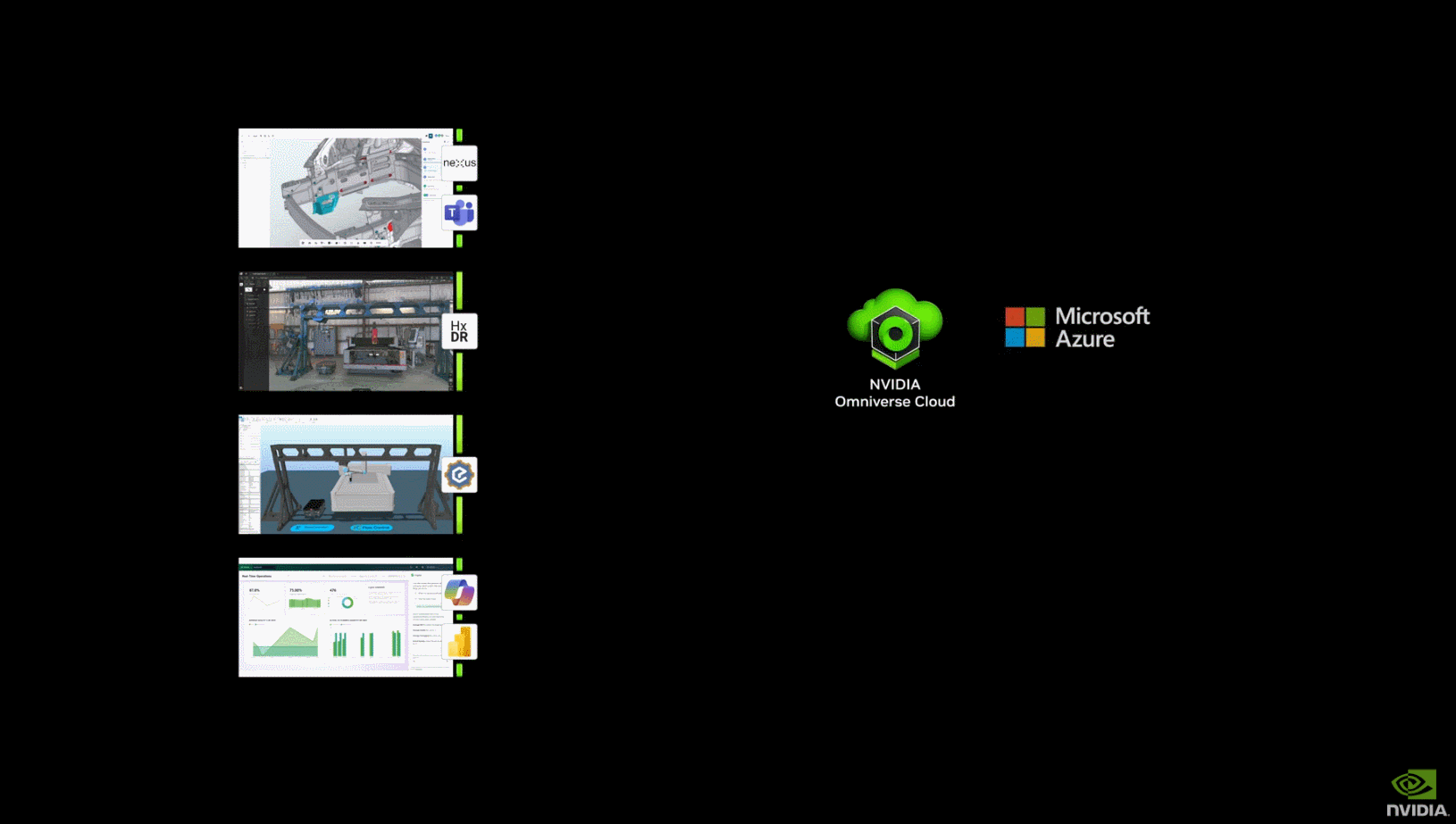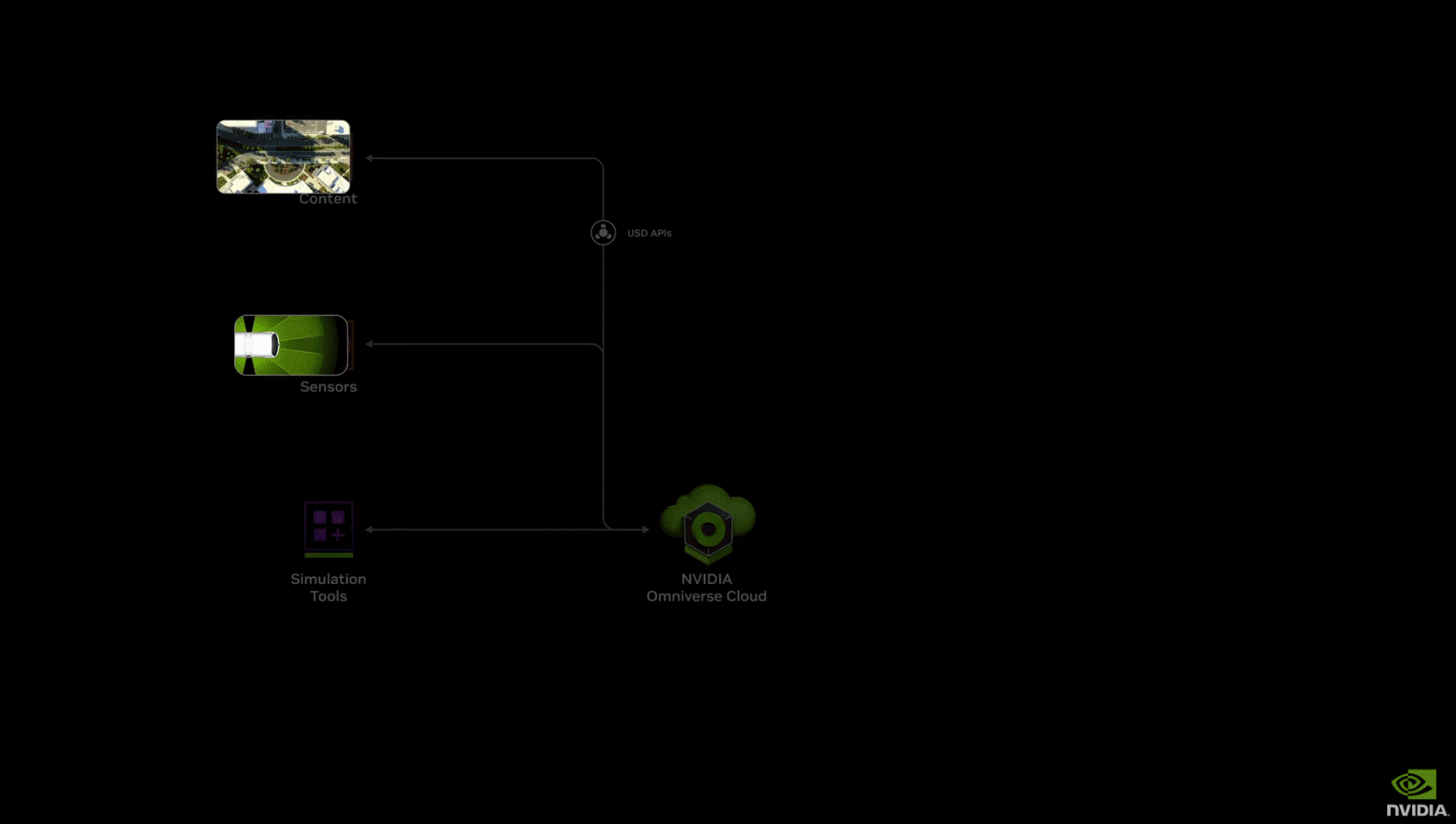 Technology peripherals
Technology peripherals
 AI
AI
 One month after the GTC conference, Nvidia's Omniverse Cloud API is rapidly landing
One month after the GTC conference, Nvidia's Omniverse Cloud API is rapidly landing
One month after the GTC conference, Nvidia's Omniverse Cloud API is rapidly landing
At this year’s GTC conference, NVIDIA announced that it has used technologies such as generative functional AI to build an industry-leading metaverse, industrial digital twin, and robot training software system.
Based on NVIDIA's real-time simulation and collaboration platform Omniverse. With the launch of the Omniverse Cloud API, tools that simulate real-world environments have expanded their reach and are now used by many companies to create industrial digital twin applications and workflows.

In March, a total of five new Omniverse Cloud APIs were introduced, allowing developers to easily integrate core Omniverse technology directly into digital twins. There are software applications for design and automation, or simulation workflows for testing and validating autonomous machines such as robots or self-driving vehicles.
These Omniverse Cloud APIs can be used individually or together, qiz includes:
- USD Rendering - Fully ray traced NVIDIA RTX rendering for generating OpenUSD data;
- USD writing - allows users to modify OpenUSD data and interact with it;
- USD query - implement scene query and scene interaction;
- USD notification - track USD changes and provide updates;
- Omniverse Channel — Connect users, tools and the world to achieve cross-scenario collaboration.
Meanwhile, some of the world’s largest industrial software manufacturers are incorporating Omniverse Cloud API into their software portfolios, including: Ansys, Cadence, Dassault, Hexagon, Microsoft, Rockwell, Siemens and Trimble.
“In the future, all products manufactured will have digital twins.” Nvidia founder and CEO Jensen Huang said. "Omniverse is an operating system for building and operating physically true digital twins. Omniverse and generative AI are foundational technologies for digitizing the $50 billion heavy industry market."
Last week, NVIDIA spoke at a media event Introduced the latest progress of Omniverse Cloud API.
In Nvidia’s view, similar to the large language model and human feedback technology that people are currently talking about, the physical world simulation in the digital twin era also requires physical feedback to ensure that the robot can drive correctly in the real world. And Omniverse, which achieves high precision through RTX, is the best proving ground for this kind of simulation.
"The world is facing huge changes, such as unstable supply chains, power shortages, changes in economic situations, etc. More and more industrial industries hope to achieve full software-defined automation," NVIDIA China Advanced Technology Market Manager Shi Chengqiu said. "Many companies are building digital twins to improve operational efficiency and save costs by simulating world operations. Once an industrial-grade digital twin is built, it will be of great significance to robotic systems, artificial intelligence training venues, etc."
NVIDIA’s service suite includes APIs to help developers bring full platform capabilities. Omniverse-powered applications fundamentally change complex 3D workflows, enabling everyone from individuals to multinational enterprises to build unified physical workflows.
NVIDIA introduced a series of vendors that have adopted Cloud API:
At Siemens, starting with the cloud-based product lifecycle management (PLM) software Teamcenter X, its Xcelerator platform has adopted Omniverse Cloud API.
Through the NVIDIA Omniverse API, Siemens provides customers with generative AI capabilities that make their physics-based digital twins more immersive. Siemens expects this to help its customers design, build and test next-generation products, manufacturing processes and factories virtually before they are built in the real world.
Engineering simulation software provider Ansys is adopting the Omniverse Cloud API to enable data interoperability and RTX visualization in solutions such as Ansys AVxcelerate for autonomous vehicles, Ansys Perceive EM for 6G simulation, and NVIDIA accelerated solvers such as Ansys Fluent.
Compute software provider Cadence is implementing the Omniverse Cloud API into the Cadence Reality Digital Twin Platform so that enterprises can design, simulate and optimize data centers in a digital twin before physical buildout.
Omniverse updates also lead to the development of autonomous machines such as self-driving cars and robots.

Sensor data is critical for training, testing and validating full-stack autonomy from perception to planning and control. Omniverse Cloud API connects a rich ecosystem of simulation tools and application development (such as Foretellix's Foretify platform, CARLA, MathWorks, etc.) and industry-leading sensor solution providers (such as FORVIA HELLA, Luminar, SICK AG and Sony Semiconductor Solutions), to enable full-stack training and testing using high-fidelity, physics-based sensor simulations.
The Omniverse Cloud API is planned to be available first on Microsoft Azure and will be available to developers later this year for use on NVIDIA-accelerated systems both self-hosted and in the cloud.
Nvidia said that over the past five years, the company has been working on building advanced graphics systems based on accurate physical rendering.
The latest update puts Omniverse in the cloud, allowing developers to directly integrate the latest technologies in graphics and AI into their existing workflows.
For enterprises, this method eliminates the need to worry about redevelopment. After the emergence of Cloud API, we can quickly adapt to the new way of working based on Omniverse without making major changes.
The above is the detailed content of One month after the GTC conference, Nvidia's Omniverse Cloud API is rapidly landing. For more information, please follow other related articles on the PHP Chinese website!

Hot AI Tools

Undresser.AI Undress
AI-powered app for creating realistic nude photos

AI Clothes Remover
Online AI tool for removing clothes from photos.

Undress AI Tool
Undress images for free

Clothoff.io
AI clothes remover

Video Face Swap
Swap faces in any video effortlessly with our completely free AI face swap tool!

Hot Article

Hot Tools

Notepad++7.3.1
Easy-to-use and free code editor

SublimeText3 Chinese version
Chinese version, very easy to use

Zend Studio 13.0.1
Powerful PHP integrated development environment

Dreamweaver CS6
Visual web development tools

SublimeText3 Mac version
God-level code editing software (SublimeText3)

Hot Topics
 1386
1386
 52
52
 How to delete a repository by git
Apr 17, 2025 pm 04:03 PM
How to delete a repository by git
Apr 17, 2025 pm 04:03 PM
To delete a Git repository, follow these steps: Confirm the repository you want to delete. Local deletion of repository: Use the rm -rf command to delete its folder. Remotely delete a warehouse: Navigate to the warehouse settings, find the "Delete Warehouse" option, and confirm the operation.
 What to do if the git download is not active
Apr 17, 2025 pm 04:54 PM
What to do if the git download is not active
Apr 17, 2025 pm 04:54 PM
Resolve: When Git download speed is slow, you can take the following steps: Check the network connection and try to switch the connection method. Optimize Git configuration: Increase the POST buffer size (git config --global http.postBuffer 524288000), and reduce the low-speed limit (git config --global http.lowSpeedLimit 1000). Use a Git proxy (such as git-proxy or git-lfs-proxy). Try using a different Git client (such as Sourcetree or Github Desktop). Check for fire protection
 How to generate ssh keys in git
Apr 17, 2025 pm 01:36 PM
How to generate ssh keys in git
Apr 17, 2025 pm 01:36 PM
In order to securely connect to a remote Git server, an SSH key containing both public and private keys needs to be generated. The steps to generate an SSH key are as follows: Open the terminal and enter the command ssh-keygen -t rsa -b 4096. Select the key saving location. Enter a password phrase to protect the private key. Copy the public key to the remote server. Save the private key properly because it is the credentials for accessing the account.
 How to download git projects to local
Apr 17, 2025 pm 04:36 PM
How to download git projects to local
Apr 17, 2025 pm 04:36 PM
To download projects locally via Git, follow these steps: Install Git. Navigate to the project directory. cloning the remote repository using the following command: git clone https://github.com/username/repository-name.git
 How to solve the efficient search problem in PHP projects? Typesense helps you achieve it!
Apr 17, 2025 pm 08:15 PM
How to solve the efficient search problem in PHP projects? Typesense helps you achieve it!
Apr 17, 2025 pm 08:15 PM
When developing an e-commerce website, I encountered a difficult problem: How to achieve efficient search functions in large amounts of product data? Traditional database searches are inefficient and have poor user experience. After some research, I discovered the search engine Typesense and solved this problem through its official PHP client typesense/typesense-php, which greatly improved the search performance.
 How to connect to the public network of git server
Apr 17, 2025 pm 02:27 PM
How to connect to the public network of git server
Apr 17, 2025 pm 02:27 PM
Connecting a Git server to the public network includes five steps: 1. Set up the public IP address; 2. Open the firewall port (22, 9418, 80/443); 3. Configure SSH access (generate key pairs, create users); 4. Configure HTTP/HTTPS access (install servers, configure permissions); 5. Test the connection (using SSH client or Git commands).
 How to submit empty folders in git
Apr 17, 2025 pm 04:09 PM
How to submit empty folders in git
Apr 17, 2025 pm 04:09 PM
To submit an empty folder in Git, just follow the following steps: 1. Create an empty folder; 2. Add the folder to the staging area; 3. Submit changes and enter a commit message; 4. (Optional) Push the changes to the remote repository. Note: The name of an empty folder cannot start with . If the folder already exists, you need to use git add --force to add.
 How to add public keys to git account
Apr 17, 2025 pm 02:42 PM
How to add public keys to git account
Apr 17, 2025 pm 02:42 PM
How to add a public key to a Git account? Step: Generate an SSH key pair. Copy the public key. Add a public key in GitLab or GitHub. Test the SSH connection.



